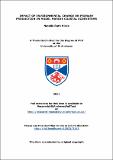Files in this item
Impact of environmental change on primary production in model marine coastal ecosystems
Item metadata
| dc.contributor.advisor | Paterson, D. M. (David M.) | |
| dc.contributor.author | Hicks, Natalie | |
| dc.coverage.spatial | vi, 135, [106] | en_US |
| dc.date.accessioned | 2012-09-22T20:17:09Z | |
| dc.date.available | 2012-09-22T20:17:09Z | |
| dc.date.issued | 2011 | |
| dc.identifier.uri | https://hdl.handle.net/10023/3143 | |
| dc.description.abstract | Coastal ecosystems, including estuaries, provide a range of services to humans, mediated by the species within these ecosystems. Microphytobenthos (MPB) play a vital role in many key processes within estuarine ecosystems, and provide a food source for higher trophic levels. Anthropogenic activity is already causing changes to ecosystems, through pollution, overexploitation and, more recently, climate change. Increasing temperature and carbon dioxide levels, and altered biodiversity, are likely to affect species, and their interactions, within these ecosystems. Much ecological research has focused on the effects of a single stressor on specific species or ecosystems, with relatively little work examining the effects of multiple stressors. The research in this thesis investigates the effects of altered environmental variables (light, tidal regime, temperature and carbon dioxide) and different macrofaunal diversity on primary production (MPB biomass) through a series of manipulative lab-based mesocosm experiments. This work also examines the temporal variability of environmental stressors on species across two trophic levels. Results demonstrate how multiple environmental stressors interact in a complex and non-additive way to determine an ecosystem response (MPB biomass, nutrient concentration), and the effects of altered biodiversity were underpinned by strong species effects. Temporal variation of stressors had a strong effect on ecosystem response. In marine coastal ecosystems, environmental changes through ocean acidification will have economic and social repercussions, directly impacting the human services and livelihoods that these systems provide. As such, future research should be focused on identifying and mitigating the inevitable multiple effects that future global change may have on coastal ecosystems. | en_US |
| dc.language.iso | en | en_US |
| dc.publisher | University of St Andrews | en |
| dc.subject.lcc | QH541.5C65H5 | |
| dc.subject.lcsh | Coastal ecology | en_US |
| dc.subject.lcsh | Marine ecology | en_US |
| dc.subject.lcsh | Benthos--Microbiology | en_US |
| dc.subject.lcsh | Coastal biodiversity | en_US |
| dc.subject.lcsh | Benthos--Climatic factors | en_US |
| dc.title | Impact of environmental change on primary production in model marine coastal ecosystems | en_US |
| dc.type | Thesis | en_US |
| dc.type.qualificationlevel | Doctoral | en_US |
| dc.type.qualificationname | PhD Doctor of Philosophy | en_US |
| dc.publisher.institution | The University of St Andrews | en_US |
This item appears in the following Collection(s)
Items in the St Andrews Research Repository are protected by copyright, with all rights reserved, unless otherwise indicated.

